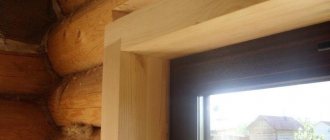High-quality installation of windows involves not only the correct installation of profiles and double-glazed windows, but also the fastening of numerous slopes and window sills. This finishing can be done either by specialists or by the homeowner himself, which will significantly save on repairs. Installing window sills and slopes on plastic windows is not particularly difficult, so it is quite possible to do such work with your own hands.
Mandatory preparatory activities
Immediately after installing the plastic windows, it is necessary to carry out mandatory measures, only after completion of which can you begin installing the window sill and slopes. The gaps between the opening and the profile are foamed with polyurethane foam. This work is carried out as carefully as possible using special guns, which ensure high-quality uniform filling of the space, while eliminating the distortion of the window frame.
When installing, the window sill will need to be leveled horizontally . Accordingly, even before proceeding with its installation, you will need to check the horizontalness of the base with a building level. If necessary, significant protrusions are removed with a chisel, and the existing recesses must be additionally filled with cement mortar, leveling the surface. It is prohibited to install the window sill by eye without using the appropriate tool.
Additionally, so-called jointing is performed , which allows you to correctly install plastic slopes and then decorate them with tiles or putty. Special additional elements are used, which are installed in the corner of the opening and attached to sealant or cement mortar.
Joining the openings in the future will significantly simplify the installation of the window sill and slopes, eliminating cracking of the putty and other finishing problems.
Determining the right size
The choice of material is only part of the task. Next, you will need to correctly calculate the size of the workpiece. To do this, you need to measure the width of the window opening and add from 6 to 10 cm to it. This is necessary so that the window sill extends beyond the slopes by about 3 cm.
It should be remembered that the corners (plastic), as well as the F profile, should not extend beyond it.
You can give an example. Let's say the window has a width of one meter, then for it you need to take a window sill 110 cm long, of which 2 cm will go to the light angle of rotation, and allowances (on the sides) will take another 8 cm. If you look at the balcony block, then it is usually at the door extends forward 1 cm, and on the other hand, rests firmly against the wall. Thus, the length of the structure can be calculated.
The width is quite easy to calculate. The plate is placed under the window by two centimeters, and its protrusion should be about 5-7 centimeters, so the windows should not fog up, because such a protrusion will not interfere with the air circulation from the radiator, thereby preventing condensation from collecting on the window. You will need to use a tape measure to measure the depth of the window opening.
As a result, you need to add the three resulting values and their sum is the width.
Template sizes of plastic window sill slabs
Plastic sheets for window sills are sold in standard sizes, and are cut to the required dimensions during installation. For old houses this will be very convenient, since it will be possible to select any size for non-standard structures.
The template size of the window sill is from 4 to 6 meters in length.
Template sizes of wooden window sill slabs
They can be spliced or veneered along their length. Their thickness is usually 4 cm. Solid-lamella or veneered window sills have thin plates (lamellas) that are glued along the entire length.
To prevent the wood from twisting during use, the outside is veneered with thin wood inserts. The surface of the product can be varnished or tinted to extend its service life and give it a sophisticated look.
The dimensions of a wooden window sill are:
- Minimum width 15 cm, maximum 1 m;
- Minimum length 70 cm, maximum 3 m.
Benefits of DIY repairs
Today, the cost of services of professional installers and builders is so high that many homeowners decide to carry out certain repair work themselves. The use of ready-made plastic elements or drywall makes it easier to attach window sills and slopes. As a result, the homeowner's costs are reduced, while he does not lose in the quality of the repairs performed.
The advantages of self-finishing windows include the following::
- excellent quality of work performed;
- ease of finishing window openings;
- the possibility of significant savings;
- the homeowner can choose one or another material for decorating windows.
You only need to act strictly in accordance with the technology for working with a particular material, and the use of ready-made plastic slopes can significantly simplify repairs. Therefore, the homeowner, even without the relevant experience, can save money by finishing the windows with his own hands.
Pollination methods
As I found out, there are 2 types of pollination of tomatoes indoors - natural and chemical. I will consider with you how to pollinate tomatoes on the windowsill, and decide which is the most effective method.
Natural pollination
Natural pollination is divided into natural and artificial.
Natural
The natural option is when the breeze sways the branches and pollen moves from one flower to another.
How I organize:
- I open the windows, creating a draft in warm weather.
- If it is below 15 degrees outside, then I place the fan at a distance of 50 cm from the bush.
- In both cases, the branches sway and scatter pollen over all the buds.
Artificial
When the ovaries do not turn out naturally, I do artificial pollination and use mechanical actions to help the bushes pollinate the buds.
How I pollinate:
- I shake the bushes a little or tap the brushes with a stick, the pollen falls and the stamens are pollinated.
- I apply an electric toothbrush to the flower and collect pollen, spreading it to neighboring flowers.
Using a watercolor brush with soft bristles, I collect pollen with rotational movements and transfer it, like a bee, to other inflorescences.
Do you pollinate tomatoes with a toothbrush?
Not really
Chemical pollination
Friends, I am not a supporter of using chemicals when growing, but the results are amazing - the yield increases. I’ll tell you about ways to use ovary stimulants.
Spraying and dipping
During flowering in the morning, I irrigate the buds with a stimulant solution, trying not to get it on the young leaves.
How to dilute:
- I dilute the drug “Ovary” 1 g in 500 ml of warm water. I apply the composition with a sprayer to all flowers and ovaries 2 times: when the tomato bloomed and when it began to bloom.
- In between, I spray boric acid once (1 g + 1 liter of water).
Do you use the “Ovary” preparation for pollination?
Not really
There is a synthetic drug of a new generation of stimulants “Tomato”. I dilute 1 ml of the drug in 0.5 liters of water, add 1 drop of liquid soap to the mug, mix and dip the blossomed buds in the solution.
Author's note
Natalia Papanova
Blog author
I use the “Tomato” stimulator only once a season.
Watch the video on why you should remove the crown flower.
Having decided on pollination on the windowsill, get ready for summer and find out how to pollinate tomatoes on the balcony.
Installation of window sills
Immediately after installing the windows and carrying out the appropriate preparatory work, you can begin installing the window sill, which should protrude 10-15 centimeters from the opening, resting on the wall. The width of the protrusions will depend on the size of the starting slope strip, which is measured with a tape measure and subsequently an order for a plastic structure is made.
Installation work is not particularly difficult, and to carry it out you will need an electric jigsaw or a simple hand saw. You just need to be careful when sawing the plastic sheet, which will allow you to install the window sill in a high-quality manner yourself, saving on the cost of hiring professional installers.
To install the window sill you will need the following:
- hand jigsaw;
- level;
- spray foam gun.
The window sill is attached to mounting foam, which fills all the voids. It is an excellent heat insulator and bonds the plastic surface well to slopes and concrete bases. You just need to take care of high-quality hydro- and thermal insulation: this will prevent the formation of condensation, which can subsequently flow down and spoil the finish, forcing the homeowner to carry out expensive repairs.
Correct sequence of work
Before proceeding directly to installing the window sill, it is necessary to prepare the materials used and clean the space under the window. If installation is carried out using a vapor barrier, then it is preferable to choose a material with an adhesive base on one side, which will ensure quality fixation, simplifying subsequent repair work.
Having installed the vapor barrier and prepared the base for attaching the window sill, you can begin foaming the cracks. The entire space is filled with foam, which is poured in lines as tightly as possible, leaving no voids. It must be taken into account that in the future the sealant will expand; accordingly, its thickness will increase by approximately 25%. A standard size window sill usually requires two cans of polyurethane foam, which is enough to seal all the cracks and firmly fix the plastic sheet and base.
Wooden blocks are laid on both sides of the opening for additional support, the thickness of which should subsequently allow the window sill to fit into the space under the window without gaps or cracks. The bars are fixed strictly according to the level or with a slight slope of the plane towards the room. The installed supports can be additionally foamed with mounting foam, ensuring their high-quality fixation.
All that remains is to carefully place the window sill on the bars, and then secure it with additional sealant. All gaps at the top and bottom are foamed, which will eliminate the appearance of drafts and the formation of condensation. A load of 5-6 kilograms should be placed on the windowsill, which is removed after about a day.
Why do you need a support profile for plastic windows?
The architectural features of modern and old buildings are such that in the area of the lower border of the window, air is pumped under the external tides. In Soviet times, they combated this by placing heating radiators directly under the windows.
Now they are often trying to remove them from prominent places, so special attention should be paid to the window sill area and eliminate the possibility of cold bridges appearing there. To solve this problem, a stand profile is installed
The presence of internal air chambers improves the thermal insulation of the window, and the design of the strip makes it easier to solve several issues at once.
Installation of slopes
After installing the window sill, you can begin attaching the slopes. These are window openings that are located inside and outside along the perimeter of the window. The main purpose of the slopes is to hide the frame fasteners and joints. At the same time, the room is prevented from cooling down and the formation of condensation, which can cause ice and subsequently force expensive repairs. High-quality slopes will have excellent sound and heat insulation. They are easy to use, durable, and their installation is not particularly difficult.
You can already find plastic slopes on sale, or you can make them yourself from a PVC strip, which is cut to size and subsequently fixed with self-tapping screws or glue directly in the window opening. To install a window sill and PVC slopes with your own hands, you will need the following tools and materials :
- white silicone;
- fasteners;
- scissors for cutting metal and plastic;
- heat insulator;
- level;
- perforator;
- stapler with staples;
- wooden slats 15 millimeters thick;
- plastic F-shaped and U-shaped strips.
It is not recommended to remove the protective film from plastic windows until the installation of the slopes is completed: this will keep the parts neat and clean. A rail is attached along the outer edge of the perimeter of the slopes, for which a drill, screws or dowels are used. To get a straight line, you will need to constantly monitor the geometry with a level. The presence of such a base rail will subsequently give the plastic element the necessary strength and rigidity.
A starting strip is attached to the edge of the window using self-tapping screws, into which the slope panel is inserted. Such a plank should fit snugly against the opening, and be sure to check its horizontal and vertical positions. Only after this can you begin to attach the F-shaped strip. This strip is measured exactly according to the dimensions of the slope, and the remaining shanks are cut off with a saw or grinder.
The starting bar is fastened with a stapler using metal staples. If additional insulation is planned, then the space between the open strip and the window opening is filled with a heat insulator, and then covered with a plastic strip. All that remains for the homeowner to do is to carry out the finishing touches. For such work, plaster, non-woven and paper wallpaper, or any other plastic panels can be used.
On sale you can find ready-made plastic slopes for windows, the use of which can significantly simplify the installation and subsequent finishing of the opening. You just need to select them for specific frame sizes, which guarantees the quality and durability of the work performed.
Factory-made slopes are assembled and then glued into the window using sealant or any similar adhesive composition.
Construction of plastic windows
To properly understand the installation process, you need to have an understanding of window design. Let's start with materials and names. Plastic windows are made of polyvinyl chloride, which is abbreviated as PVC. Hence the second name - PVC windows.
The main element of any window is the frame. For plastic windows, the frame is made from a special multi-chamber profile. It is divided by partitions into a number of cells - chambers. The more of these cells, the warmer the window will be. When they talk about how many cameras there will be in a plastic window, they have the number of cells in the profile.
Windows from the same manufacturer with different numbers of cameras in the profile
In the middle of the structure, in the largest chamber, a blue insert is visible. This is a reinforcing element of increased rigidity. It gives the profile the required strength. In plastic windows this insert is made of plastic, in metal-plastic windows it is made of metal (usually aluminum). That's the whole difference between them.
The structure of a metal-plastic window
There is also a division of profiles into classes: economy, standard and premium. The best choice if you need normal windows is the standard class. In economy class, the partitions are too thin and they begin to freeze almost from the moment they are installed. Premium has a high price due to options that, in fact, are not needed.
If you want to have the best profile for plastic windows, take the standard class of any factory. There is no particular difference between products from different companies. They have long been standardized and all managers’ stories about the advantages are fairy tales. If they are made on factory equipment, there is no difference between them: all factory profiles have long been standardized.
Window profiles are white as standard, but can also be brown - to match the color of any wood, and even pink - upon request. Windows made from colored profiles are more expensive than similar white ones.
Window structure
To understand what is being discussed in the description of the installation process, you need to know the name of each component of the structure.
What does a plastic window consist of?
It consists of:
- Frames. This is the base of the window.
- If the window consists of several parts, the frame is divided into parts by an impost - a vertical component. If the window is made of two parts, there is one impost; If there are three parts, there are two, etc.
- The opening part of the window is called the sash, the stationary part is called the capercaillie. A double-glazed window is inserted into them - two, three or more glasses, hermetically sealed together. A foil tape is laid between the glasses to ensure tightness. There are double-glazed windows with special properties: with reinforced glass, tinted and energy efficient, which, according to manufacturers, reduces heat loss through the windows. There are also double-glazed windows with inert gas pumped between the glass panes. It also reduces heat loss.
- Double-glazed windows are pressed to the frame with a cap - a thin plastic strip. The tightness of the connection is ensured by a rubber seal (it is usually black).
- Locking fittings are installed on the sashes. This is a specific set of mechanisms that provide opening and locking. They can be different, as they provide different functionality: opening, opening with ventilation, opening + ventilation + micro-ventilation.
- To ensure tightness, rubber seals are installed on all parts - frame, impost and sashes.
At the bottom of the outer side of the frame (the one facing the street) there are drainage holes that are closed with special caps. Through them, condensation that forms inside due to the difference in temperature outside and indoors is discharged outside.
Drainage holes
The window also has a sill - a board on the outside that removes precipitation and a window sill on the inside. The side and top parts on the street and indoor side are sealed with slopes. They can also be made of plastic or made using a different technology.
Using drywall, wood and plaster
Slopes and window sills can be made not only of plastic, but also of wood, plasterboard, and lined with mosaics, tiles or plaster. In each specific case, one or another operating technology is chosen depending on the preferences of the homeowner and the characteristics of the windows, their size and shape. The easiest way is to finish the opening with plaster, for which additional leveling is carried out using cement mortar, and to strengthen the surface, a plastic mesh is used, on top of which plastering is carried out with decorative materials.
Drywall is very popular, making it possible to significantly simplify the work performed. The strips cut from gypsum plasterboard are attached to a special metal sheathing or directly with self-tapping screws and anchors, followed by plastering of the surface. Many homeowners choose the option of a durable plastic window sill and inexpensive plasterboard slopes with their subsequent wallpapering.
In private homes, window treatments and window sills made of wood are very popular. Based on the measurements obtained, cabinetmakers make external and internal platbands with slopes, which are subsequently attached to small, inconspicuous nails or self-tapping screws. The only drawback of such wooden slopes and window sills is the need to regularly treat them with various impregnations that protect the wood from moisture.
Removing an old window or preparing an opening
As I already said, usually in apartments and houses plastic windows are installed instead of old wooden ones. Removing a wooden window is relatively easy. First you need to remove the sashes with glass. To do this, they need to be lifted and removed from their hinges. It is often impossible to lift the frame by hand, so it is better to use a pry bar here, unless of course you are Arnie Schwarzinger!
A window without sashes looks like a wooden frame with a vertical crossbar in the middle. This crossbar should be sawed in half to make removing the frame easier.
Before removing the frame, you need to remove the window sill. In multi-storey buildings, old window sills are usually reinforced concrete. They are not easy to take out. Here you need a sledgehammer, with which you need to break the window sill from the bottom up, and then pull it towards you. If it doesn’t help, then drill a small hole and lay in dynamite. We light the wick, wait for the old window sill to disappear. Guys, if anything, then I was joking :), otherwise you never know?!
When dismantling a window unit, you must first loosen and break out the sawn vertical crossbar. After this, the window frame is removed in parts, starting from the top. When dismantling is completed, you need to clear the window opening of construction debris and insulation. It is also advisable to remove small debris and dust using a brush around the perimeter of the entire window opening.
This is about removing an old window, but I had to make the window opening from scratch. To do this, in the wall into which daylight would soon spill, I had to mark out the future dimensions of the window. Usually they take measurements first, but for me it’s the other way around - I adjust the opening to fit the future window :)
Using a hammer drill, I hollow out the opening (sorry about the quality)
Then I reinforced the window opening with metal lintels
I plastered all the irregularities and the opening is ready!










